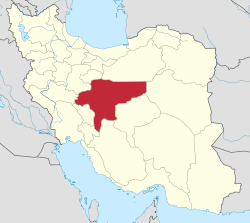Imamzadeh Ahmad
| Imamzadeh Ahmad | |
|---|---|
 The fountain in the sahn, in 2019 | |
| Religion | |
| Affiliation | Shia Islam |
| Ecclesiastical or organizational status | Imamzadeh and mausoleum |
| Status | Active |
| Location | |
| Location | Esfahan, Isfahan province |
| Country | Iran |
Location of the complex in Iran | |
 | |
| Geographic coordinates | 32°39′13″N 51°40′48″E / 32.653611°N 51.68°E |
| Architecture | |
| Type | Islamic architecture |
| Style | |
| Completed |
|
| Specifications | |
| Dome(s) | One (maybe more) |
| Materials | Stone; stucco; plaster; mirrors |
 The imamzadeh dome | |
| Official name | Imamzadeh Ahmad |
| Type | Built |
| Designated | 7 December 1935 |
| Reference no. | 234 |
| Conservation organization | Cultural Heritage, Handicrafts and Tourism Organization of Iran |
Imamzadeh Ahmad (Persian: امامزاده احمد; Arabic: مرقد أحمد) is a Shi'ite imamzadeh in Isfahan, Iran. The Imamzadeh comprises a mausoleum, to the north and west of which are two iwans; the tomb faces a vast sahn where several famous people, like Amir Kabir's daughter and Naser al-Din Shah's sister and wife, are buried. The emamzadeh himself was likely the Sultan Ali's son, who has been buried in Mashhad-e Ardehal.[1]
The complex was added to the Iran National Heritage List on 7 December 1935, administered by the Cultural Heritage, Handicrafts and Tourism Organization of Iran.
Overview
[edit]The oldest part of the structure is a single piece of white stone, which is 3 metres (9.8 ft) long, said to be a piece of Somnath stone.[1] The stone is placed under a wooden reticulated window, facing an alley. Jaberi Ansari wrote about the stone in the history of Isfahan and Rey as follows:[1]
"Mahmud of Ghazni brought a stone as a souvenir from Somnath in India. It is said that it had been a part of the most important idol in that land. This stone was transferred to Isfahan and a century later it was cut in half and made a stone trough from one half in Vazir Tahmasb school and the other half was dragged on the ground (for demonstrating the abjection of the idol) and then it was taken to emamzadeh Ahmad."
Imamzadeh Ahmad was completed in 1141 CE, during the Seljukid era, however the present structure was completed in 1703 CE, during the Safavid era. The ceiling of the mausoleum is covered by Muqarnas works. Around the sepulcher there is a poem in golden Nastaliq script, in which Zellossoltan has mentioned repairments and revampings of this structure by him.[1]
Unlike few decorations of the imamzadeh's tomb, the tomb of Amir Kabir's daughter and Naser al-Din Shah Qajar's sister and wife have been fully decorated with stucco, painting and mirror decoration.
See also
[edit]- Shia Islam in Iran
- List of imamzadehs in Iran
- List of mausoleums in Iran
- List of the historical structures in the Isfahan province
References
[edit]External links
[edit]![]() Media related to Imamzadeh Ahmad (Isfahan) at Wikimedia Commons
Media related to Imamzadeh Ahmad (Isfahan) at Wikimedia Commons
- 12th-century religious buildings and structures in Iran
- Buildings and structures completed in 1141
- Buildings and structures in Isfahan
- Mausoleums, shrines and tombs on the Iran National Heritage List
- Domes in Iran
- Imamzadehs in Iran
- Mausoleums in Isfahan
- Religious buildings and structures completed in the 1140s
- Religious buildings and structures with domes
- Seljuk architecture in Iran
- Shia shrines






